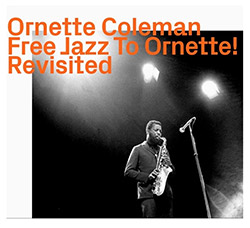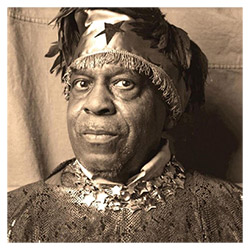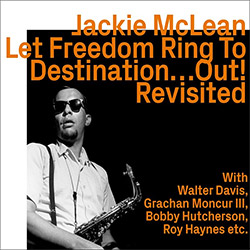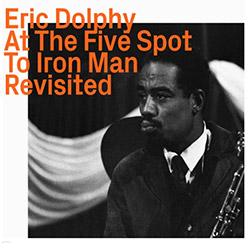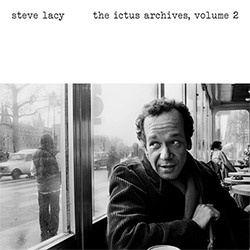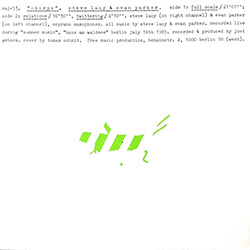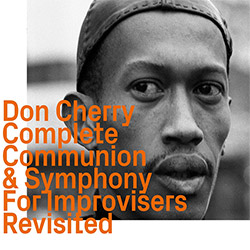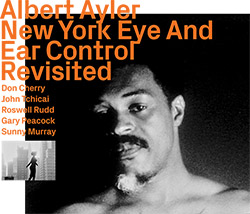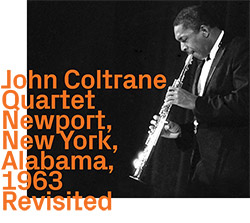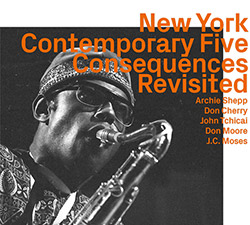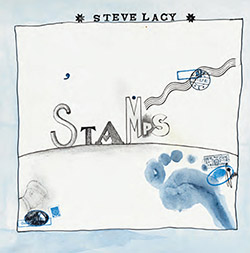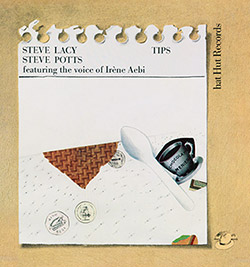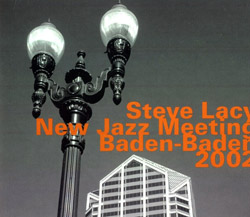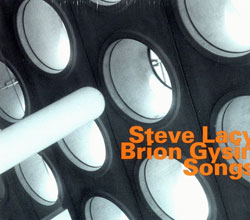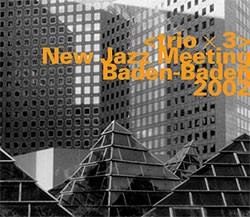![Lacy, Steve: The Classic Albums [4 CDs] (Enlightenment) Lacy, Steve: The Classic Albums [4 CDs] (Enlightenment)](https://www.teuthida.com/productImages/misc4/35213.jpg)
A 4-CD box set collecting 8 albums under Steve Lacy's name from 1957 to 1965, with sidement including Don Cherry, Mal Waldron, Kent Carter, Carla Bley, Louis Moholo, &c: Soprano Sax; Reflections; The Straight Horn of Steve Lacy; Evidence; Disposability; Jazz Realities; Sortie;The Forest and the Zoo.
In Stock
Quantity in Basket: None
Log In to use our Wish List
Shipping Weight: 8.00 units
Sample The Album:
Steve Lacy-soprano saxophone
Wynton Kelly-piano
Buell Neidlinger-bass
Denis Charles-drums
Mal Waldron-piano
John Ore-bass
Roy Haynes-drums
Don Cherry-trumpet
Carl Brown-bass
Billy Higgins-drums
Aldo Romano-drums
Kent Carter-bass
Carla Bley-piano
Michael Mantler-trumpet
Enrico Rava-trumpet
Johnny Dyani-bass
Louis Moholo-Moholo-drums
Click an artist name above to see in-stock items for that artist.
UPC: 823564038537
Label: Enlightenment
Catalog ID: EN4CD9235
Squidco Product Code: 35213
Format: 4 CDs
Condition: New
Released: 2024
Country: UK
Packaging: Digipack - 8 panel
"This 4-CD collection collates 8 of the finest albums revered soprano saxophonist Steve Lacy recorded as either leader or co-leader. A pioneer and originator of experimental jazz, Lacy is widely credited as bringing the soprano sax back into the mainstay after a period of neglect. This new set serves to highlight the great man's importance, acting as an ideal starting point for those unacquainted or a welcome reminder to those already versed."-Enlightment
Artist Biographies
• Show Bio for Steve Lacy "Steve Lacy (July 23, 1934 - June 4, 2004), born Steven Norman Lackritz in New York City, was a jazz saxophonist and composer recognized as one of the important players of soprano saxophone. Coming to prominence in the 1950s as a progressive dixieland musician, Lacy went on to a long and prolific career. He worked extensively in experimental jazz and to a lesser extent in free improvisation, but Lacy's music was typically melodic and tightly-structured. Lacy also became a highly distinctive composer, with compositions often built out of little more than a single questioning phrase, repeated several times. The music of Thelonious Monk became a permanent part of Lacy's repertoire after a stint in the pianist's band, with Monk's songs appearing on virtually every Lacy album and concert program; Lacy often partnered with trombonist Roswell Rudd in exploring Monk's work. Beyond Monk, Lacy performed the work of jazz composers such as Charles Mingus, Duke Ellington and Herbie Nichols; unlike many jazz musicians he rarely played standard popular or show tunes. Lacy began his career at sixteen playing Dixieland music with much older musicians such as Henry "Red" Allen, Pee Wee Russell, George "Pops" Foster and Zutty Singleton and then with Kansas City jazz players like Buck Clayton, Dicky Wells, and Jimmy Rushing. He then became involved with the avant-garde, performing on Jazz Advance (1956), the debut album of Cecil Taylor,:55 and appearing with Taylor's groundbreaking quartet at the 1957 Newport Jazz Festival; he also made a notable appearance on an early Gil Evans album. His most enduring relationship, however, was with the music of Thelonious Monk: he recorded the first album to feature only Monk compositions (Reflections, Prestige, 1958) and briefly played in Monk's band in 1960:241 and later on Monk's Big Band and Quartet in Concert album (Columbia, 1963). Lacy's first visit to Europe came in 1965, with a visit to Copenhagen in the company of Kenny Drew; he went to Italy and formed a quartet with Italian trumpeter Enrico Rava and the South African musicians Johnny Dyani and Louis Moholo (their visit to Buenos Aires is documented on The Forest and the Zoo, ESP, 1967). After a brief return to New York, he returned to Italy, then in 1970 moved to Paris, where he lived until the last two years of his life. He became a widely respected figure on the European jazz scene, though he remained less well known in the U.S. The core of Lacy's activities from the 1970s to the 1990s was his sextet: his wife, singer/violinist Irene Aebi,:272 soprano/alto saxophonist Steve Potts, pianist Bobby Few, bassist Jean-Jacques Avenel, and drummer Oliver Johnson (later John Betsch). Sometimes this group was scaled up to a large ensemble (e.g. Vespers, Soul Note, 1993, which added Ricky Ford on tenor sax and Tom Varner on French horn), sometimes pared down to a quartet, trio, or even a two-saxophone duo. He played duos with pianist Eric Watson. Lacy also, beginning in the 1970s, became a specialist in solo saxophone; he ranks with Sonny Rollins, Anthony Braxton, Evan Parker, and Lol Coxhill in the development of this demanding form of improvisation. Lacy was interested in all the arts: the visual arts and poetry in particular became important sources for him. Collaborating with painters and dancers in multimedia projects, he made musical settings of his favourite writers: Robert Creeley, Samuel Beckett, Tom Raworth, Taslima Nasrin, Herman Melville, Brion Gysin and other Beat writers, including settings for the Tao Te Ching and haiku poetry. As Creeley noted in the Poetry Project Newsletter, "There's no way simply to make clear how particular Steve Lacy was to poets or how much he can now teach them by fact of his own practice and example. No one was ever more generous or perceptive." In 1992, he was the recipient of a MacArthur Fellowship (nicknamed the "genius grant"). He also collaborated with a wide range of musicians, from traditional jazz to the avant-garde to contemporary classical music. Outside of his regular sextet, his most regular collaborator was pianist Mal Waldron,:244-245 with whom he recorded a number of duet albums (notably Sempre Amore, a collection of Ellington/Strayhorn material, Soul Note, 1987). Lacy played his 'farewell concerts to Europe' in Belgium, in duo and solo, for a small but motivated public. This happened in Brussels, Antwerp, Ghent, Bruge and Bergen. This recollection is published by Naked Music. In Ghent he played with the classical violinist Mikhail Bezverkhni, winner of Queen Elisabeth Concours. He returned to the United States in 2002, where he began teaching at the New England Conservatory of Music in Boston, Massachusetts. One of his last public performances was in front of 25,000 people at the close of a peace rally on Boston Common in March 2003, shortly before the US-led invasion of Iraq. After Lacy was diagnosed with cancer in August 2003, he continued playing and teaching until weeks before his death on June 4, 2004 at the age of 69." ^ Hide Bio for Steve Lacy • Show Bio for Wynton Kelly "Wynton Kelly (pianist) was born in Jamaica on December 2, 1931 and passed away on April 12, 1971 in Toronto, Ontario, Canada. Wynton Kelly was a greatly underrated talent, who was both an elegant piano soloist with a rhythmically infectious solo style in which he combined boppish lines with a great feeling for the blues as well as a particularly accomplished accompanist, gifted with perfect pitch and a highly individual block chording style. Kelly's work was always highly melodic, especially in his ballad performances, while an irresistible sense of swing informed his mid and up-tempo performances. Though he was born on the island of Jamaica, Wynton grew up in Brooklyn. His academic training appears to have been brief, but he was a fast musical developer who made his professional debut in 1943, at the age of eleven or twelve. His initial musical environment was the burgeoning Rhythm and Blues scene of the mid to late 1940s. Wynton played his first important gig with the R&B combo of tenor saxophonist Ray Abrams in 1947. He spent time in hard hitting R&B combos led by Hot Lips Page, Eddie "Cleanhead" Vinson and Eddie "Lockjaw" Davis, in addition to the gentler environment of Johnny Moore's Three Blazers. In April 1949, Wynton played piano backing vocalist Babs Gonzales in a band that also included J.J. Johnson, Roy Haynes and a young Sonny Rollins. Kelly's first big break in the jazz world came in 1951, when he became Dinah Washington's accompanist. In July 1951 Kelly also made his recording debut as a leader on the Blue Note label at the age of 19. After his initial stint with Dinah Washington Kelly gigged with the combos of Lester Young and Dizzy Gillespie and recorded with Gillespie's quintet in 1952. Wynton fulfilled his army service between 1952 and the summer or 1954 and then rejoined Washington and the Dizzy Gillespie Big Band (1957). By this time Kelly had become one of the most in demand pianists on record. He distinguished himself on record with such talent as J.J. Johnson, Sonny Rollins, Johnny Griffin and especially Hank Mobley whom Kelly inspired to some of his best work on classic Blue Note albums like Soul Station, Work Out, and Roll Call. Wynton proved himself as a superb accompanist on the Billie Holiday Clef sessions of June 1956 and showed his mettle both as an accompanist and soloist on the star-studded Norman Granz session with Coleman Hawkins, Paul Gonsalves, Dizzy Gillespie and Stan Getz in 1957 that produced the fine Sittin' In album on the Verve label. In 1957 Kelly left Gillespie and formed his own trio. He finally recorded his second album as a leader for the Riverside label in January 1958, six years after his Blue Note debut. In early 1959 Miles Davis invited Wynton to joint his sextet as a replacement for Bill Evans. Kind of Blue, recorded in March 1959, on which he shares the piano stool with Evans, Kelly excels on the track "Freddie Freeloader" a medium temp side that is closest to the more theory-free jazz of the mid-fifties. Wynton proved a worthy successor to Red Garland and Bill Evans in the Miles Davis combo, together with bassist Paul Chambers and drummer Jimmy Cobb, an old colleague from Dinah Washington's rhythm section, he established a formidable rapport. Kelly likewise appears on a single track from John Coltrane's Giant Steps, replacing Tommy Flanagan on "Naima". During his stay with Davis, Kelly recorded his fine Kelly Blue for Riverside and three albums for Vee Jay. By the end of 1962 Kelly, Chambers and Cobb formed the Wynton Kelly Trio, which soon made its mark. The Kelly Trio remained a regular unit for a number of years and reached the height of their popularity after they joined up with guitarist Wes Montgomery, resulting in three albums, a live set in New York's Half Note, a September 1965 studio album for Verve, and a live set at the Half Note for the Xanadu Label. Kelly's trio, now with Cecil McBee and Ron McClure kept working during till the late 1960s. Kelly suffered from epilepsy most of his life, and succumbed to a heart attack induced by a seizure in Toronto, Canada on April 12, 1971 at the age of 39. Kelly had a daughter, Tracy, in 1963, with partner Anne. The track "Little Tracy", on the LP Comin' in the Back Door, is named after Kelly's daughter. Tracy Matisak is a now a Philadelphia television personality. Kelly recorded as a leader for Blue Note, Riverside Records, Vee-Jay, Verve, and Milestone. Kelly had a daughter, Tracy, in 1963, with partner Anne. The track "Little Tracy", on the LP Comin' in the Back Door, is named after Kelly's daughter. Tracy Matisak is a now a Philadelphia television personality. Kelly's second cousin, bassist Marcus Miller, also performed with Miles Davis in the 1980s and 1990s. Another cousin is pianist Randy Weston." ^ Hide Bio for Wynton Kelly • Show Bio for Buell Neidlinger "Buell Neidlinger (March 2, 1936 - March 16, 2018) was an American cellist and double bassist. He has worked with a variety of pop and jazz performers, prominently with iconoclastic pianist Cecil Taylor in the 1950s and '60s. Neidlinger was born in New York City to the former Jane Buell and Roger Nidlinger. He was raised in Westport, Connecticut, where his father ran a cargo shipping business. He played cello in his youth, and began studying double bass after a music teacher recommended it to strengthen his hands. He took lessons from jazz bassist Walter Page. In his teens, Neidlinger suffered a nervous breakdown which he attributed to the pressure of being perceived as a child prodigy on cello. While institutionalized, he met jazz pianist Joe Sullivan who was in treatment for alcoholism. Neidlinger dropped out of Yale University after one year, where he had been studying orchestral music. He moved to New York City and began playing in various jazz settings. He joined Cecil Taylor's group in 1955, played with Herbie Nichols and recorded extensively with Taylor's groups with Steve Lacy and with Archie Shepp among others until 1961. He was also involved with new directions in classical music (John Cage, Mauricio Kagel, George Crumb) and Gunther Schuller' s Third Stream music. In 1971, Neidlinger moved to California. He became the principal bassist for the Los Angeles Chamber Orchestra and was also principal bassist in the Warner Bros. studio orchestra for 30 years. He worked extensively as an orchestral and as a session bassist before becoming a musical educator at the New England Conservatory and CalArts. Together with Marty Krystall he founded K2B2 Records. The sessions Neidlinger performed on as a strings player included Tony Bennett's "I Left My Heart In San Francisco" and the Eagles' "Hotel California". In 1983, he performed on the Antilles Records release Swingrass '83. In 1997, Neidlinger moved to Whidbey Island, Washington State. There, he played in a band called Buellgrass, which included fiddler Richard Greene and featured their version of bluegrass music. Neidlinger's fourth wife, Margaret Storer, was also a bass player. They played baroque music with friends; he played cello, while she played violin. Neidlinger's final recording was The Happenings, accompanied by Howard Alden on guitar and Marty Krystall on bass clarinet and flute, released in December 2017." ^ Hide Bio for Buell Neidlinger • Show Bio for Denis Charles "Denis Alphonso Charles (December 4, 1933 - March 26, 1998) was a jazz drummer. Charles was born in St. Croix, Virgin Islands, and first played bongos at age seven with local ensembles in the Virgin Islands. In 1945, he moved to New York, and gigged frequently around town. In 1954, he began working with Cecil Taylor, and the pair collaborated until 1958. Following this he played with Steve Lacy, Gil Evans, and Jimmy Giuffre. He befriended Ed Blackwell, and the two influenced each other. He recorded with Sonny Rollins on a calypso-tinged set, and then returned to time with Lacy, with whom he played until 1964. He worked with Archie Shepp and Don Cherry in 1967, but heroin addiction saw him leave the record industry until 1971. In the 1970s and 1980s, he played regularly on the New York jazz scene with Frank Lowe, David Murray, Charles Tyler, Billy Bang, and others, and also played funk, rock, and traditional Caribbean music. He released three discs as a leader between 1989 and 1992, and died of pneumonia in his sleep in New York in 1998. Charles died four days after a five-week European tour with the Borgmann/Morris/Charles (BMC) Trio, with Wilber Morris and Thomas Borgmann. His last concert with this trio took place at the Berlin's Willy-Brandt-Haus. With the BMC Trio he recorded some albums in his last two years. A fifth CD was released after he died: The Last Concert - Dankeschön, Silkheart Records, 1999. In 2002, Veronique Doumbe released a film documentary, Denis A. Charles: An Interrupted Conversation, about the life of Charles." ^ Hide Bio for Denis Charles • Show Bio for Mal Waldron "Malcolm Earl "Mal" Waldron (August 16, 1925 - December 2, 2002) was an American jazz pianist, composer, and arranger. He started playing professionally in New York in 1950, after graduating from university. In the following dozen years or so Waldron led his own bands and played for those led by Charles Mingus, Jackie McLean, John Coltrane, and Eric Dolphy, among others. During Waldron's period as house pianist for Prestige Records in the late 1950s, he appeared on dozens of albums and composed for many of them, including writing his most famous song, "Soul Eyes", for Coltrane. Waldron was often an accompanist for vocalists, and was Billie Holiday's regular accompanist from April 1957 until her death in July 1959. A breakdown caused by a drug overdose in 1963 left Waldron unable to play or remember any music; he regained his skills gradually, while redeveloping his speed of thought. He left the U.S. permanently in the mid-1960s, settled in Europe, and continued touring internationally until his death. In his 50-year career, Waldron recorded more than 100 albums under his own name and more than 70 for other band leaders. He also wrote for modern ballet, and composed the scores of several feature films. As a pianist, Waldron's roots lay chiefly in the hard bop and post-bop genres of the New York club scene of the 1950s, but with time he gravitated more towards free jazz. He is known for his dissonant chord voicings and distinctive later playing style, which featured repetition of notes and motifs." ^ Hide Bio for Mal Waldron • Show Bio for John Ore "John Ore (December 17, 1933 - August 22, 2014) was an American jazz bassist. Ore attended the New School of Music in Philadelphia from 1943 to 1946, studying cello and followed this with studies on bass at Juilliard. In the 1950s he worked with Tiny Grimes, George Wallington, Lester Young, Ben Webster, Coleman Hawkins, Elmo Hope, Bud Powell and Freddie Redd. From 1960 to 1963 he played in Thelonious Monk's quartet, and then with the Les Double Six of Paris in 1964. Later in the 1960s he played again with Powell and also recorded with Teddy Wilson. In the 1970s he worked with Earl Hines. He was with the Sun Ra Arkestra in 1982. He never recorded an album as a leader. In a blindfold test with DownBeat in 1963, fellow bassist Ray Brown praised Ore's playing on an album with Monk's quartet, giving the bassist "four stars...for clean playing." ^ Hide Bio for John Ore • Show Bio for Roy Haynes "Roy Owen Haynes (born March 13, 1925) is an American jazz drummer. He is among the most recorded drummers in jazz. In a career lasting over 75 years he has played swing, bebop, jazz fusion, avant-garde jazz and is considered the father of modern jazz drumming. "Snap Crackle" was a nickname given to him in the 1950s. He has led bands such as the Hip Ensemble. His albums Fountain of Youth and Whereas were nominated for a Grammy Award. He was inducted into the Modern Drummer Hall of Fame in 1999. His son Graham Haynes is a cornetist; his son Craig Holiday Haynes and grandson Marcus Gilmore are both drummers. " ^ Hide Bio for Roy Haynes • Show Bio for Don Cherry "Imagination and a passion for exploration made Don Cherry one of the most influential jazz musicians of the late 20th century. A founding member of Ornette Coleman's groundbreaking quartet of the late '50s, Cherry continued to expand his musical vocabulary until his death in 1995. In addition to performing and recording with his own bands, Cherry worked with such top-ranked jazz musicians as Steve Lacy, Sonny Rollins, Archie Shepp, Albert Ayler, John Coltrane, and Gato Barbieri. Cherry's most prolific period came in the late '70s and early '80s when he joined Nana Vasconcelos and Collin Walcott in the worldbeat group Codona, and with former bandmates Charlie Haden and Ed Blackwell, and saxophonist Dewey Redman in the Coleman-inspired group Old and New Dreams. Cherry later worked with Vasconcelos and saxophonist Carlos Ward in the short-lived group Nu. The Avant-Garde Born in Oklahoma City in 1936, he first attained prominence with Coleman, with whom he began playing around 1957. At that time Cherry's instrument of choice was a pocket trumpet (or cornet) -- a miniature version of the full-sized model. The smaller instrument -- in Cherry's hands, at least -- got a smaller, slightly more nasal sound than is typical of the larger horn. Though he would play a regular cornet off and on throughout his career, Cherry remained most closely identified with the pocket instrument. Cherry stayed with Coleman through the early '60s, playing on the first seven (and most influential) of the saxophonist's albums. In 1960, he recorded The Avant-Garde with John Coltrane. After leaving Coleman's band, Cherry played with Steve Lacy, Sonny Rollins, Archie Shepp, and Albert Ayler. In 1963-1964, Cherry co-led the New York Contemporary Five with Shepp and John Tchicai. With Gato Barbieri, Cherry led a band in Europe from 1964-1966, recording two of his most highly regarded albums, Complete Communion and Symphony for Improvisers. Cherry began the '70s by teaching at Dartmouth College in 1970, and recorded with the Jazz Composer's Orchestra in 1973. He lived in Sweden for four years, and used the country as a base for his travels around Europe and the Middle East. Cherry became increasingly interested in other, mostly non-Western styles of music. In the late '70s and early '80s, he performed and recorded with Codona, a cooperative group with percussionist Nana Vasconcelos and multi-instrumentalist Collin Walcott. Codona's sound was a pastiche of African, Asian, and other indigenous musics. Art Deco Concurrently, Cherry joined with ex-Coleman associates Charlie Haden, Ed Blackwell, and Dewey Redman to form Old and New Dreams, a band dedicated to playing the compositions of their former employer. After the dissolution of Codona, Cherry formed Nu with Vasconcelos and saxophonist Carlos Ward. In 1988, he made Art Deco, a more traditional album of acoustic jazz, with Haden, Billy Higgins, and saxophonist James Clay. Multikulti Until his death in 1995, Cherry continued to combine disparate musical genres; his interest in world music never abated. Cherry learned to play and compose for wood flutes, tambura, gamelan, and various other non-Western instruments. Elements of these musics inevitably found their way into his later compositions and performances, as on 1990's Multi Kulti, a characteristic celebration of musical diversity. As a live performer, Cherry was notoriously uneven. It was not unheard of for him to arrive very late for gigs, and his technique -- never great to begin with -- showed on occasion a considerable, perhaps inexcusable, decline. In his last years, especially, Cherry seemed less self-possessed as a musician. Yet his musical legacy is one of such influence that his personal failings fade in relative significance." ^ Hide Bio for Don Cherry • Show Bio for Carl Brown Carl Brown was an American Jazz bassist, known for his work with Steve Lacy and Don Cherry, and the group The Embers Quintet. ^ Hide Bio for Carl Brown • Show Bio for Billy Higgins "As a member of the groundbreaking Ornette Coleman-led quartet that launched the free jazz renaissance, Billy Higgins remains one of the most important and controversial drummers in music history. An uncommonly versatile and intuitive player, his nimble rhythmic patterns achieved a perfect balance between function and form, inspiring the great trumpeter Lee Morgan to remark "Higgins] never overplays, but you always know he's there." Born October 11, 1936, in Los Angeles, Higgins began his career playing R&B, supporting headliners including Bo Diddley, Amos Milburn, and Jimmy Witherspoon. In 1953 he joined high school friend and trumpeter Don Cherry in the Jazz Messiahs, a group also featuring saxophonist James Clay; three years later, he began his session career, in the months to follow appearing on recording dates led by saxophonist Lucky Thompson and bassist Red Mitchell. Around this time, Higgins and Cherry met Coleman through mutual friend Clay. A virtual unknown, the Texas-born saxophonist was supporting himself with menial jobs while working diligently to hone a musical lexicon liberated from the restraints of conventional harmonic, melodic, and rhythmic structures. Both Higgins and Cherry soon joined Coleman's rehearsal group, which spent years woodshedding before finally securing its first live gigs in 1958, opening for Paul Bley at L.A.'s Hilcrest Club. Audiences were either angered or simply baffled by Coleman's radical sensibility, which he later dubbed "harmolodics," and with the 1958 release of his debut LP, Something Else!!!! The Music of Ornette Coleman, the controversy spread throughout the jazz populace, dividing musicians, critics, and fans alike. Higgins followed Coleman when he relocated the group to New York City in 1959 to begin a residency at the Five Spot Café. Love it or hate it, their music was the talk of the town, and with the addition of new bassist Charlie Haden, Coleman finally began to make concrete the sounds and structures he'd pursued for years. His 1959 Atlantic Records debut, The Shape of Jazz to Come, remains a watershed album by any definition and a schism-creating turning point in the history of the avant-garde. The accolades now heaped on Coleman also launched his collaborators to prominence, and Higgins soon emerged as one of the most sought-after drummers in contemporary jazz, proving a master of both the hard bop sensibility still dominant throughout the jazz community as well as the more fluid and abstract approach of the new generation. When a 1961 drug bust stripped Higgins of his cabaret card, prompting his exit from Coleman's band, he focused on studio work, becoming the unofficial house drummer at Blue Note Records during the label's creative zenith. In the decade to come, Higgins appeared on seminal dates including Dexter Gordon's Go!, Jackie McLean's A Fickle Sonance, and Lee Morgan's The Sidewinder, proving time and again his consummate skill and flexibility; even after Liberty Records acquired Blue Note in 1967, he remained much in-demand, maintaining his position as the premier drummer of the avant-garde with contributions to landmark efforts including Archie Shepp's 1971 LP Attica Blues and Coleman's comeback effort, Science Fiction. Higgins was also a frequent collaborator of pianist Cedar Walton, and with bassist Bill Lee and trumpeter Bill Hardman led the big-band ensemble the Brass Company for several years during the early '70s. After close to two decades on tour and in New York, Higgins settled back in Los Angeles in 1978. The following year he recorded his first-ever session as a leader, the Red label LP Soweto. Higgins recorded a few more headlining sessions in the years to follow but seemed to value most his role as a sideman, supporting saxophonist Joe Henderson and trombonist Slide Hampton during the first half of the 1980s. After appearing behind star and longtime collaborator Dexter Gordon in filmmaker Bertrand Tavernier's 1986 love letter to jazz, 'Round Midnight, Higgins reunited with Coleman, Cherry, and Haden for a 1987 tour that culminated in a new studio album, In All Languages. The following year Higgins teamed with poet Kamau Daaood to found the World Stage, a storefront enclave that hosted creative workshops, community activities, and live performances. He regularly tapped his extensive professional network to lure many of the biggest names in jazz to the World Stage site both as performers and as tutors, and ultimately Higgins turned his attention to teaching in a formal setting as well, serving on the jazz faculty at UCLA. Higgins spent much of the remainder of his life battling liver disease, a manifestation of the hepatitis he contracted decades earlier. In March 1996, he underwent a liver transplant and when his body rejected the new organ, he was forced to submit to a second procedure just 24 hours later. Higgins nevertheless returned to music a few months later, traveling to New York to renew his collaboration with Coleman. However, by 2001 his new liver began to fail, and while waiting to find a donor, he succumbed to pneumonia on May 3. Higgins was just 64 years old at the time of his death."-Jason Ankeny, Blue Note Records ^ Hide Bio for Billy Higgins • Show Bio for Aldo Romano "Aldo Romano was born in France in 1941, the son of Italian immigrants. His first instrument was the guitar, but he decided to switch to drums in 1961. Essentially self-taught, he nonetheless benefited from the advice of Michel Babault and Jacques Thollot. He admired Philly Joe Jones, Elvin Jones, Tony Williams, Ed Blackwell, and Billy Higgins. Alto sax player Jackie McLean took notice of him and they played together on one of the McLean's Parisian sojourns. He met Jean-François Jenny-Clark around the same time and the two became inseparable for a long period. Both were hired by Bernard Vitet who formed, in 1964 with François Tusques one of the first European free jazz groups." ^ Hide Bio for Aldo Romano • Show Bio for Kent Carter "Kent Carter (born June 14, 1939 in Hanover, New Hampshire, USA. Carter studied several instruments before settling on bass. In the late 50s-early 60s, he studied at Berklee College Of Music, played with Lowell Davidson, and in New York with Jazz Composers Orchestra. From the mid-60s he was in Europe with artists including as Barry Altschul, Derek Bailey, Han Bennink, Carla Bley, Paul Bley, Bobby Bradford, Don Cherry, Steve Lacy, Michael Mantler, Enrico Rava, Max Roach, Roswell Rudd and Mal Waldron. During the 70s he continued his association with Lacy, was with John Stevens' Spontaneous Music Ensemble, TOK, a trio with Takashi Kako and Oliver Johnson, and formed his own trio with Carlos Zingaro and François Dreno. By the 80s, Carter had relocated to France, teaching at the Beaux Art School, Angouleme, and with his wife forming MAD, a music, arts and dance studio. He worked in Detail, with Frode Gjerstad and Stevens, Project, with Karl Berger, Claude Bernard, Klaus Kugel, Charlie Mariano and Albrecht Maurer, and Voyage, with Beñat Achiary and David Holmes. Carter has also played with Billy Bang, Petras Vysniauskas, Theo Jorgensmann, Andreas Willers and Eckard Koltermann. Carter composes for theatre and film, and performs internationally." ^ Hide Bio for Kent Carter • Show Bio for Carla Bley "Carla Bley (born Lovella May Borg, May 11, 1936) is an American jazz composer, pianist, organist and bandleader. An important figure in the free jazz movement of the 1960s, she is perhaps best known for her jazz opera Escalator over the Hill (released as a triple LP set), as well as a book of compositions that have been performed by many other artists, including Gary Burton, Jimmy Giuffre, George Russell, Art Farmer, John Scofield and her ex-husband Paul Bley. Bley was born in Oakland, California to Emil Borg (1899-1990), a piano teacher and church choirmaster, who encouraged her to sing and to learn to play the piano, and Arline Anderson (1907-1944), who died when Bley was eight years old. After giving up the church to immerse herself in roller skating at the age of fourteen, she moved to New York at seventeen and became a cigarette girl at Birdland, where she met jazz pianist Paul Bley. She toured with him under the name Karen Borg, before she changed her name in 1957 to Carla Borg and married Paul Bley the same year adopting the Bley name. He encouraged her to start composing. The couple later divorced but she kept his surname professionally.Later life and career A number of musicians began to record Bley's compositions: George Russell recorded "Bent Eagle" on his 1960 release Stratusphunk in 1960; Jimmy Giuffre recorded "Ictus" on his album Thesis; and Paul Bley's Barrage consisted entirely of her compositions. Throughout her career Bley has thought of herself as a writer first, once describing herself as 99 percent composer and one percent pianist. In 1964 she was involved in organising the Jazz Composers Guild which brought together the most innovative musicians in New York at the time. She then had a personal and professional relationship with Michael Mantler, with whom she had a daughter, Karen, now also a musician in her own right. Bley and Mantler were married from 1965-91. With Mantler, she co-led the Jazz Composers' Orchestra and started the JCOA record label which issued a number of historic recordings by Clifford Thornton, Don Cherry and Roswell Rudd, as well as her own magnum opus Escalator Over The Hill and Mantler's The Jazz Composer's Orchestra LPs. Bley and Mantler followed with WATT Records, which has issued their recordings exclusively since the early 1970s. Bley and Mantler were pioneers in the development of independent artist-owned record labels and also started the now defunct New Music Distribution Service which specialized in small, independent labels that issued recordings of "creative improvised music". Bley has collaborated with a number of other artists, including Jack Bruce, Robert Wyatt and Pink Floyd drummer Nick Mason, whose 1981 solo album Nick Mason's Fictitious Sports was entirely written by Bley and performed by her regular band, making it in effect a Carla Bley album in all but name. She arranged and composed music for Charlie Haden's Liberation Music Orchestra, and wrote A Genuine Tong Funeral for Gary Burton. Her arrangement of the score for Federico Fellini's 8½ appeared on Hal Willner's Nino Rota tribute record, Amarcord Nino Rota. She contributed to other Willner projects, including the song "Misterioso" for the tribute to Thelonious Monk entitled That's the Way I Feel Now, which included Johnny Griffin on tenor saxophone, and the Willner-directed tribute to Kurt Weill, entitled Lost in the Stars, where she and her band contributed an arrangement of the title track, with Phil Woods on alto saxophone. In the late 1980s, she also performed with Anton Fier's Golden Palominos and played on their 1985 album, Visions of Excess. She has continued to record frequently with her own big band, which has included Blood, Sweat and Tears' notable Lew Soloff, and a number of smaller ensembles, notably the Lost Chords. Her current partner, the bassist Steve Swallow, has been her closest and most consistent musical associate in recent years and the two have recorded several duet albums. In 1997, a live version of Escalator over the Hill (re-orchestrated by Jeff Friedman) was performed for the first time in Cologne, Germany; in 1998 Escalator toured Europe, and another live performance took place in May 2006 in Essen, Germany. In 2005 she arranged the music for and performed on Charlie Haden's latest Liberation Music Orchestra tour and recording, Not in Our Name. She lives in Woodstock, New York." ^ Hide Bio for Carla Bley • Show Bio for Michael Mantler "Michael Mantler was born in 1943 in Vienna, Austria, where he studied trumpet and musicology at the Academy of Music and Vienna University. In 1962 he went to the USA to continue his studies at the Berklee School. He moved to New York two years later, playing trumpet with Cecil Taylor, among others. During that period, as a founding member of the Jazz Composer's Guild, he formed a large jazz orchestra with Carla Bley. He recorded his Jazz Composer's Orchestra album in 1968 and appeared as trumpet player on Carla Bley's Escalator Over The Hill. In 1973, he started WATT Works, a record label devoted to his and Carla Bley's music. Rarely appearing live, except with the Carla Bley Band, he recorded a series of albums for the label: No Answer (set to the words of Samuel Beckett, sung by Jack Bruce),13 (for two orchestras and piano), The Hapless Child (with words by Edward Gorey, featuring Robert Wyatt), Silence (based on the Harold Pinter play), Movies (with Larry Coryell and Tony Williams), More Movies (with Philippe Catherine), Something There (with Mike Stern, Pink Floyd's Nick Mason and the strings of the London Symphony Orchestra), Alien (with Don Preston), Live, and Many Have No Speech (based on the poetry of Samuel Beckett, Ernst Meister and Philippe Soupault). In 1991 he returned to live in Europe. Recording now for ECM, he released Folly Seeing All This (featuring the Balanescu String Quartet and including a setting of Samuel Beckett's last poem, sung by Jack Bruce), Cerco Un Paese Innocente (with singer Mona Larsen interpreting texts by Giuseppe Ungaretti), The School of Understanding (with Jack Bruce, Robert Wyatt, Mona Larsen, Don Preston, John Greaves, Per Jørgensen, Susi Hyldgaard, and Karen Mantler), the orchestral work One Symphony (paired with Songs, again featuring Mona Larsen), Hide And Seek (an album of songs with words by Paul Auster, for chamber orchestra and the voices of Robert Wyatt and Susi Hyldgaard), the anthology Review (Recordings 1968 - 2000), Concertos (featuring soloists Bjarne Roupé, Bob Rockwell, Roswell Rudd, Pedro Carneiro, Majella Stockhausen, Nick Mason, and Mantler himself on trumpet), For Two, (duets for guitarist Bjarne Roupé and pianist Per Salo) and The Jazz Composer's Orchestra Update. In recognition of his life's work he received several awards, including, among others, the Austrian State Prize for Improvised Music and the Music Prize of the City of Vienna. His subsequent work, Comment c'est (How It Is), a song cycle for voice and chamber orchestra (with his own texts, featuring Himiko Paganotti) was followed by his latest album, CODA - Orchestra Suites (reinterpretations of older works for large orchestra), as well as a series of print editions (including engraved scores of selected recorded work from a 50-year period)." ^ Hide Bio for Michael Mantler • Show Bio for Enrico Rava "Enrico Rava (born 20 August 1939), is an Italian jazz trumpeter. He started on trombone, then changed to the trumpet after hearing Miles Davis. His first commercial work was as a member of Gato Barbieri's Italian quintet in the mid-1960s; in the late 1960s he was a member of Steve Lacy's group. In 1967, Rava moved to New York City and, one month later, became a member of the group Gas Mask, which had one album released on Tonsil Records in 1970. In the 1970s and 1980s, he worked with John Abercrombie, Andrea Centazzo, Gil Evans, Richard Galliano, Joe Henderson, Joe Lovano, Pat Metheny, Michel Petrucciani, Cecil Taylor, and Miroslav Vitouš. He has also worked with Carla Bley, Lee Konitz, Jeanne Lee, Paul Motian, and Roswell Rudd. Chiefly an exponent of bebop jazz, Rava has also played in avant-garde jazz settings. With trumpeter Paolo Fresu, Rava recorded four albums on the influence of Bix Beiderbecke, Louis Armstrong, Chet Baker, and Miles Davis. Also of note are his albums Rava, L'Opera Va' and Carmen, which are his interpretations of operatic arias and overtures. In 2001, he founded a quintet with pianist Stefano Bollani and toured with Gato Barbieri and Aldo Romano. In the trio Europeans, he worked with Eberhard Weber and Swiss percussionist Reto Weber. In June 2005, Rava was awarded an Honorary Doctorate of Music from Berklee College of Music at the twentieth anniversary of jazz education at the Umbria Jazz Festival, in Perugia, Italy." ^ Hide Bio for Enrico Rava • Show Bio for Johnny Dyani "Johnny Mbizo Dyani (30 November 1945 - 24 October 1986) was a South African jazz double bassist and pianist, who played with such musicians as Don Cherry, Steve Lacy, David Murray, Finnish guitar player Jukka Syrenius and Leo Smith. Dyani was born and grew up in Duncan Village, a township of the South African city of East London. In the early 1960s, he was a member of South Africa's first integrated jazz band, The Blue Notes, with Mongezi Feza on trumpet, Dudu Pukwana on alto saxophone, Nikele Moyake on tenor saxophone, Chris McGregor on piano, and Louis Moholo on drums. In 1964, the band fled South Africa to seek musical and political freedom. Moholo explained, "We were rebels and we were trying to run away from this apartheid thing. We rebelled against the apartheid regime that whites and blacks couldn't play together. We stood up." In 1966, Dyani toured Argentina with Steve Lacy's quartet. Lacy, Dyani and Moholo recorded The Forest and the Zoo. In 1971 Dyani formed his own group Earthquake Power, and in 1972 co-founded Xaba with Mongezi Feza and Okay Temiz. Performing widely throughout Europe, Dyani moved to Copenhagen, Denmark, in the early 1970s, and about ten years later to Sweden, recording many albums under his own name. He recorded with Dollar Brand (Abdullah Ibrahim), Don Cherry, Steve Lacy, David Murray, Joseph Jarman, Clifford Jarvis, Don Moye, Han Bennink, Brotherhood of Breath, Mal Waldron, Pierre Dørge and many others. Dyani died suddenly in 1986 after a performance in West Berlin." ^ Hide Bio for Johnny Dyani • Show Bio for Louis Moholo-Moholo "Louis Tebogo Moholo (born 10 March 1940), is a South African jazz drummer. Born in Cape Town, Moholo formed The Blue Notes with Chris McGregor, Johnny Dyani, Nikele Moyake, Mongezi Feza and Dudu Pukwana, and emigrated to Europe with them in 1964, eventually settling in London, where he formed part of a South African exile community that made an important contribution to British jazz. He was a member of the Brotherhood of Breath, a big band comprising several South African exiles and leading musicians of the British free jazz scene in the 1970s and is the founder of Viva la Black and The Dedication Orchestra. His first album under his own name, Spirits Rejoice on Ogun Records, is considered a classic example of the combination of British and South African players. In the early 1970s, Moholo was also a member of the afro-rock band Assagai. He has played with many musicians, including Derek Bailey, Steve Lacy, Evan Parker, Enrico Rava, Roswell Rudd, Irène Schweizer, Cecil Taylor, John Tchicai, Archie Shepp, Peter Brötzmann, Mike Osborne, Keith Tippett, Elton Dean and Harry Miller. Moholo returned to South Africa in September 2005, performing with George Lewis at the UNYAZI Festival of Electronic Music in Johannesburg. He now goes under the name Louis Moholo-Moholo because the name is more ethnically authentic. South African promoter Slow Life in March 2017 at the Olympia Bakery in Kalk Bay, Cape Town produced a show where Louis performed along with Mark Fransman, Reza Khota, Keenan Ahrends and Brydon Bolton." ^ Hide Bio for Louis Moholo-Moholo
9/17/2024
Have a better biography or biography source? Please Contact Us so that we can update this biography.
9/17/2024
Have a better biography or biography source? Please Contact Us so that we can update this biography.
9/17/2024
Have a better biography or biography source? Please Contact Us so that we can update this biography.
9/17/2024
Have a better biography or biography source? Please Contact Us so that we can update this biography.
9/17/2024
Have a better biography or biography source? Please Contact Us so that we can update this biography.
9/18/2024
Have a better biography or biography source? Please Contact Us so that we can update this biography.
9/17/2024
Have a better biography or biography source? Please Contact Us so that we can update this biography.
9/17/2024
Have a better biography or biography source? Please Contact Us so that we can update this biography.
9/18/2024
Have a better biography or biography source? Please Contact Us so that we can update this biography.
9/17/2024
Have a better biography or biography source? Please Contact Us so that we can update this biography.
9/17/2024
Have a better biography or biography source? Please Contact Us so that we can update this biography.
9/17/2024
Have a better biography or biography source? Please Contact Us so that we can update this biography.
9/17/2024
Have a better biography or biography source? Please Contact Us so that we can update this biography.
9/18/2024
Have a better biography or biography source? Please Contact Us so that we can update this biography.
9/17/2024
Have a better biography or biography source? Please Contact Us so that we can update this biography.
9/17/2024
Have a better biography or biography source? Please Contact Us so that we can update this biography.
9/17/2024
Have a better biography or biography source? Please Contact Us so that we can update this biography.
Track Listing:
CD1
1. Day Dream 4:25
2. Alone Together 6:47
3. Work 5:27
4. Rockin' In Rhythm 4:08
5. Little Girl Your Daddy Is Calling You 4:35
6. Easy To Love 8:25
7. Four In One 6:09
8. Reflections 4:10
9. Hornin' In 5:19
10. Bye-Ya 4:41
11. Let's Call This 7:18
12. Ask Me Now 4:57
13. Skippy 4:22
CD2
1. Louise 5:24
2. Introspection 5:32
3. Donna Lee 7:50
4. Played Twice 5:53
5. Air 6:38
6. Criss Cross 5:42
7. The Mystery Song 5:45
8. Evidence 4:59
9. Let's Cool One 6:42
10. San Francisco Holiday 4:28
11. Something To Live For 5:48
12. Who Knows 5:26
CD3
1. Shuffle Boil 5:19
2. Barble 3:30
3. Chary 2:56
4. Tune 2 8:23
5. Pannonica 3:34
6. M's Transport 4:06
7. Coming On The Hudson 3:30
8. There We Were 3:04
9. Generous 3:52
10. Doctor 7:47
11. Oni Puladi 5:27
12. J.S. 3:42
13. Walking Batterie Women 6:23
14. Closer 5:34
15. CommunicationsNo. 7 9:37
CD4
1. Sortie 10:49
2. Black Elk 10:04
3. Helmy 2:09
4. Fork New York 14:01
5. Living T. Blues 3:41
6. 2-Fou 0:07
7. Forest 20:22
8. Zoo 20:30
Box Sets
Improvised Music
Jazz
Free Improvisation
NY Downtown & Metropolitan Jazz/Improv
London & UK Improv & Related Scenes
European Improvisation, Composition and Experimental Forms
Lacy, Steve
Staff Picks & Recommended Items
New in Improvised Music
Recent Releases and Best Sellers
Search for other titles on the label:
Enlightenment.


![Lacy, Steve: The Classic Albums [4 CDs] (Enlightenment) Lacy, Steve: The Classic Albums [4 CDs] (Enlightenment)](https://www.teuthida.com/productImages/full/35213.Full.jpg)
